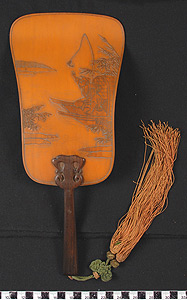Pien-mien, Face Cover Fan
2007.12.0003A
Detailed Images
Basic Information
| Artifact Identification | Pien-mien, Face Cover Fan (2007.12.0003A) |
|---|---|
| Classification/ Nomenclature |
|
| Artist/Maker | Unknown |
| Geographic Location | |
| Period | Qing Dynasty (1644-1911) |
| Date | 17th century |
| Culture | Chinese |
| Location | Not on Exhibit |
Physical Analysis
| Dimension 1 (Length) | 32.5 cm |
|---|---|
| Dimension 2 (Width) | 13.5 cm |
| Dimension 3 (Depth) | .2 cm |
| Weight | 67 g |
| Measuring Remarks | Under Review |
| Materials | Plant--Bamboo, Textile, Pigment--Dye, Plant--Wood, Plant--Zitan |
| Manufacturing Processes | Carved, Dyeing, Woodbending, Twisting, Drilling |
Research Remarks
| Description | This is a fixed fan (pien-mien) of the Qing Dynasty (1644-1911). Three types of Chinese fans evolved: the face cover fan (pien-mien), the ceremonial fan (T'uan-shan), and the folding fan (Che-shan). All three were used for social purposes, such as the pien-mien being a face cover to conceal emotions. Fan painting became an accepted and esteemed art around the Song Dynasty (960-1279). This particular fan is constructed both of bamboo and zitan wood, with the handle made from zitan and the fan made in the liu qing style of carving bamboo skin. Bamboo is a revered material for Chinese arts due to its association with longevity given that it is capable of flourishing throughout winter. Zitan is valued due to it being the hardest and heaviest of the hardwoods and a reliable material for Chinese decorative arts. The carving technique of Chinese lacquer, due to the complicated drying process, was not perfected until relatively late in history. The raw lacquer sap taken from the rhus tree species, particularly Rhus verniciflua, would not harden if applied too thickly, which meant that lacquer painting required a lengthy layering technique. Carved items of the commonly-used red lacquer style (ti hong) were not created until the Yuan Dynasty (1279-1368), and the lacquer manufacturing procedures are recorded for both the Yuan and early Ming periods. A wooden base was covered with a thick layer of black lacquer (mixed with ash to promote hardening) which served as a smooth surface for the additional layers. A mixture of red and yellow layers, usually between 100 to 200, were then applied, and the artist then carved into these layers to produce a desired design. In order to indicate when the artist had to stop carving, several black layers would have been added as markers at an earlier point of the layering process. |
|---|---|
| Published Description | N/A |
| Bibliography | Hutt, Julia. Understanding Far Eastern Art: A Complete Guide to the Arts of China, Japan and Korea - Ceramics, Sculpture, Painting, Prints, Lacquer, Textiles and Metalwork. New York: E.P. Dutton, 1987. |
Artifact History
| Credit Line/Dedication | Fred A. Freund Collection |
|---|---|
| Reproduction | N/A |
Contact
All information about our collection is constantly reviewed and updated. Please contact Dery Martínez-Bonilla, Registrar, if there is any information you are looking for that isn't currently online.
